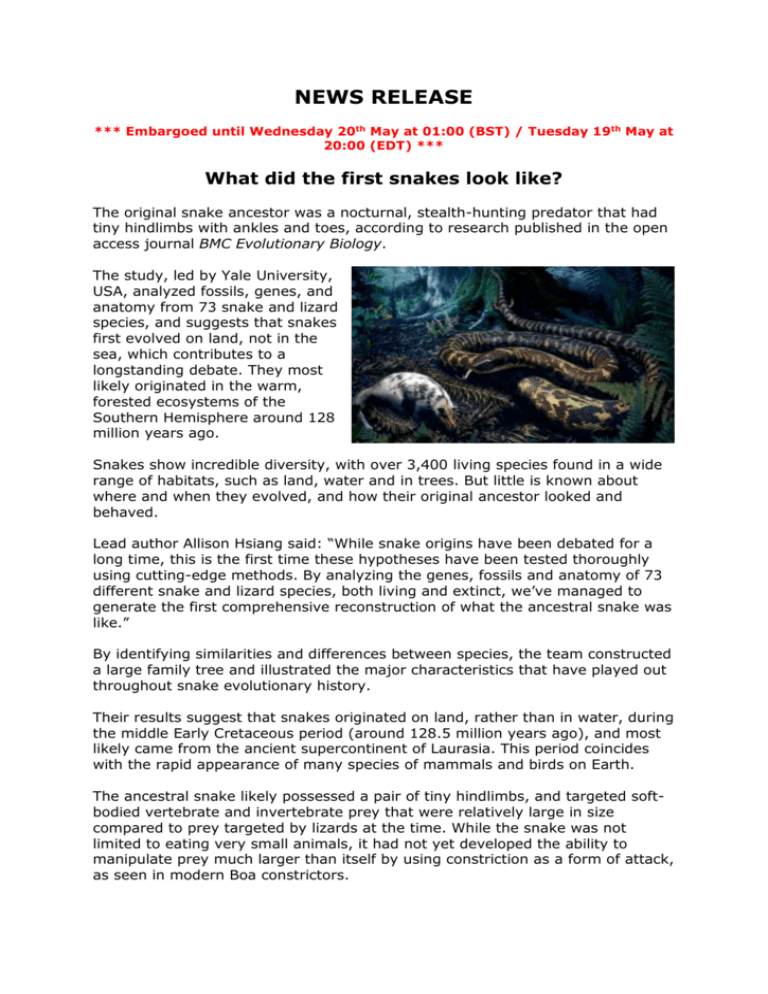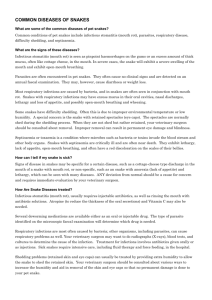Media Release
advertisement

NEWS RELEASE *** Embargoed until Wednesday 20th May at 01:00 (BST) / Tuesday 19th May at 20:00 (EDT) *** What did the first snakes look like? The original snake ancestor was a nocturnal, stealth-hunting predator that had tiny hindlimbs with ankles and toes, according to research published in the open access journal BMC Evolutionary Biology. The study, led by Yale University, USA, analyzed fossils, genes, and anatomy from 73 snake and lizard species, and suggests that snakes first evolved on land, not in the sea, which contributes to a longstanding debate. They most likely originated in the warm, forested ecosystems of the Southern Hemisphere around 128 million years ago. Snakes show incredible diversity, with over 3,400 living species found in a wide range of habitats, such as land, water and in trees. But little is known about where and when they evolved, and how their original ancestor looked and behaved. Lead author Allison Hsiang said: “While snake origins have been debated for a long time, this is the first time these hypotheses have been tested thoroughly using cutting-edge methods. By analyzing the genes, fossils and anatomy of 73 different snake and lizard species, both living and extinct, we’ve managed to generate the first comprehensive reconstruction of what the ancestral snake was like.” By identifying similarities and differences between species, the team constructed a large family tree and illustrated the major characteristics that have played out throughout snake evolutionary history. Their results suggest that snakes originated on land, rather than in water, during the middle Early Cretaceous period (around 128.5 million years ago), and most likely came from the ancient supercontinent of Laurasia. This period coincides with the rapid appearance of many species of mammals and birds on Earth. The ancestral snake likely possessed a pair of tiny hindlimbs, and targeted softbodied vertebrate and invertebrate prey that were relatively large in size compared to prey targeted by lizards at the time. While the snake was not limited to eating very small animals, it had not yet developed the ability to manipulate prey much larger than itself by using constriction as a form of attack, as seen in modern Boa constrictors. While many ancestral reptiles were most active during the daytime (diurnal), the ancestral snake is thought to have been nocturnal. Diurnal habits later returned around 50-45 million years ago with the appearance of Colubroidea - the family of snakes that now make up over 85% of living snake species. As colder night time temperatures may have limited nocturnal activity, the researchers say that the success of Colubroidea may have been facilitated by the return of these diurnal habits. The results suggest that the success of snakes in occupying a range of habitats over their evolutionary history is partly due to their skills as ‘dispersers’. Snakes are estimated to be able to travel ranges up to 110,000 square kilometres, around 4.5 times larger than lizards. They are also able to inhabit environments that traditionally hinder the dispersal of terrestrial animals, having invaded aquatic habitats multiple times in their evolutionary history. -ENDSMedia Contact Joel Winston Media Officer BioMed Central T: +44 (0)20 3192 2081 M: +44 (0)7766540147 E: Joel.Winston@biomedcentral.com Notes to editor: 1. Image: Reconstruction of the ancestral crown-group snake, based on this study. Artwork by Julius Csotonyi. Full resolution image available to download from: http://bit.ly/1FmWwiw You are free to re-use this image on the condition that you credit Julius Csotonyi. 2. Research article Allison Y Hsiang, Daniel J Field, Timothy H Webster, Adam DB Behlke, Matthew B Davis, Rachel A Racicot and Jacques A Gauthier The origin of snakes: revealing the ecology, behavior, and evolutionary history of early snakes using genomics, phenomics, and the fossil record BMC Evolutionary Biology 2015 doi: 10.1186/s12862-015-0358-5 During embargo, article available here: http://bit.ly/1JL3mMz After embargo, article available at journal website here: http://dx.doi.org/10.1186/s12862-015-0358-5 Please name the journal in any story you write. If you are writing for the web, please link to the article. All articles are available free of charge, according to BioMed Central's open access policy. 3. BMC Evolutionary Biology is an open access, peer-reviewed journal that considers articles on all aspects of molecular and non-molecular evolution of all organisms, as well as phylogenetics and palaeontology. BMC Evolutionary Biology is part of the BMC series which publishes subject-specific journals focused on the needs of individual research communities across all areas of biology and medicine. We offer an efficient, fair and friendly peer review service, and are committed to publishing all sound science, provided that there is some advance in knowledge presented by the work. 4. BioMed Central is an STM (Science, Technology and Medicine) publisher which has pioneered the open access publishing model. All peer-reviewed research articles published by BioMed Central are made immediately and freely accessible online, and are licensed to allow redistribution and reuse. BioMed Central is part of Springer Science+Business Media, a leading global publisher in the STM sector. www.biomedcentral.com











